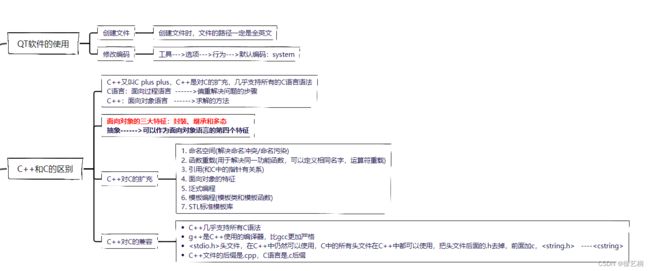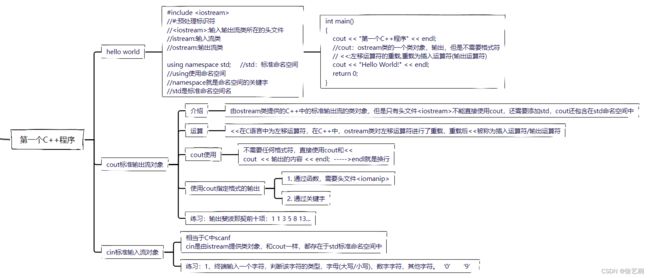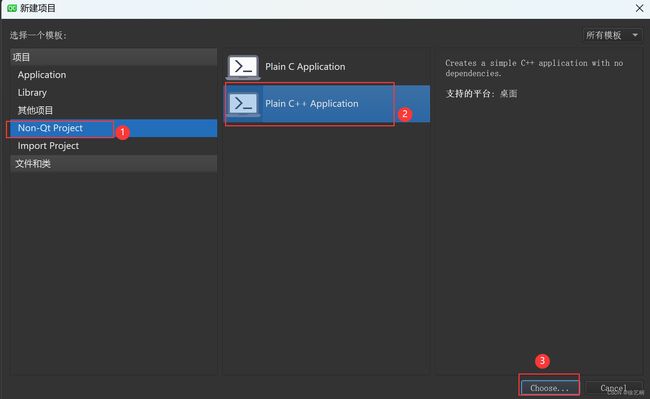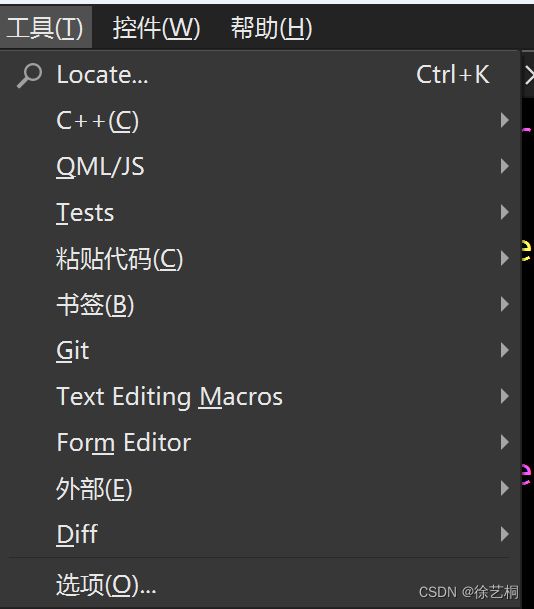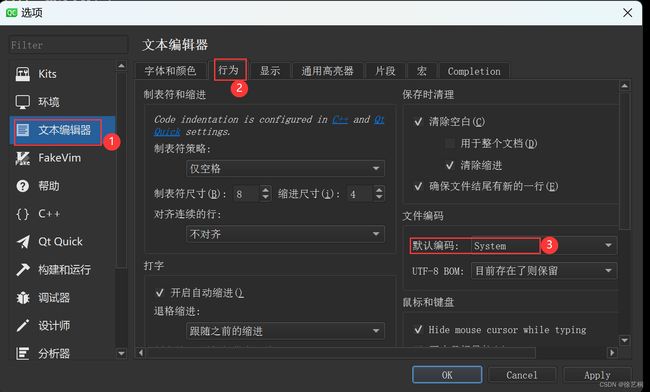0821|C++day1 初步认识C++
一、思维导图
二、知识点回顾
【1】QT软件的使用
1)创建文件
创建文件时,文件的路径一定是全英文
2)修改编码
工具--->选项--->行为--->默认编码:system
【2】C++和C的区别
C++又叫C plus plus,C++是对C的扩充,几乎支持所有的C语言语法
C语言:面向过程语言 ------>偏重解决问题的步骤
C++:面向对象语言 ------>求解的方法面向对象的三大特征:封装、继承和多态
抽象------>可以作为面向对象语言的第四个特征
1)C++对C的扩充
- 命名空间(解决命名冲突/命名污染)
- 函数重载(用于解决同一功能函数,可以定义相同名字,运算符重载)
- 引用(和C中的指针有关系)
- 面向对象的特征
- 泛式编程
- 模板编程(模板类和模板函数)
- STL标准模板库
2)C++对C的兼容
- C++几乎支持所有C语法
- g++是C++使用的编译器,比gcc更加严格
头文件,在C++中仍然可以使用,C中的所有头文件在C++中都可以使用,把头文件后面的.h去掉,前面加c, ---- - C++文件的后缀是.cpp,C语言是.c后缀
【3】第一个C++程序
1)hello world
#include
//#:预处理标识符
//:输入输出流类所在的头文件
//istream:输入流类
//ostream:输出流类
using namespace std; //std:标准命名空间
//using使用命名空间
//namespace就是命名空间的关键字
//std是标准命名空间名
int main()
{
cout << "第一个C++程序" << endl;
//cout:ostream类的一个类对象,输出,但是不需要格式符
// <<:左移运算符的重载,重载为插入运算符(输出运算符)
cout << "Hello World!" << endl;
return 0;
} 2)cout标准输出流对象
i)介绍
由ostream类提供的C++中的标准输出流的类对象,但是只有头文件不能直接使用cout,还需要添加std,cout还包含在std命名空间中
ii)运算
ostream类对左移运算符进行了重载,重载后
iii)cout的使用
不需要任何格式符,直接使用cout和
cout endl就是换行
iv)使用cout指定格式的输出
- 通过函数,需要头文件
- 通过关键字
#include
#include
using namespace std;
int main()
{
int a = 16;
cout << a << endl; //16
// ----------------通过关键字控制格式------------------------
cout << hex << a << endl; //10 hex十六进制输出
cout << a << endl; //10 ---->因为上一行的cout已经指定了格式,如果想结束掉上述的格式,重新指定格式
cout << dec << a << endl; //dec表示十进制的输出
cout << oct << a << endl; //oct表示八进制输出
cout << "-----------------------------" << endl;
// ----------------通过函数控制格式------------------------
cout << setbase(16) << a << endl;
cout << setbase(8) << a << endl;
cout << a << endl; //20,使用函数仍然改变了cout的输出格式
cout << setbase(10) << a << endl;
cout << "指定宽度的输出<==>%nd" << endl;
cout << setw(4) << left << a ; //功能和%-4d一样,左对齐使用left,如果不加left默认是右对齐
cout << "小数的指定宽度输出 " << endl;
cout << setprecision(4) << 3.1456 << endl;
//指定的是包含小数点的位置,3.146
return 0;
} 练习:输出斐波那契的前10项
1 1 2 3 5 8 13 ····
#include
using namespace std;
int main()
{
int arr[10];
int i = 0;
for(i=0;i<10;i++)
{
if(i==0 || i==1)
{
arr[i]=1;
}
else
arr[i]=arr[i-2]+arr[i-1];
cout << arr[i] << endl;
}
return 0;
}
3)cin标准输入流对象
相当于C中scanf
cin是由istream提供类对象,和cout一样,都存在于std标准命名空间中
#include
#include
using namespace std;
int main()
{
int a;
//scanf("%d",&a); //需要控制格式
cin >> a; //cin加上右移运算符重载,再加上变量名,使用cin输入不需要加变量的地址
cout << a << endl;
char c;
cin >> c; //cin可以实现任意类型的输入
cout << "从终端获取的字符c=" << c << endl;
return 0;
} 练习:终端输入一个字符,判断该字符的类型,字母(大写/小写)、数字字符,其他字符
#include
#include
using namespace std;
int main()
{
char a;
//scanf("%d",&a); //需要控制格式
cin >> a; //cin加上右移运算符重载,再加上变量名,使用cin输入不需要加变量的地址
if(a>='0'&&a<='9')
{
cout << "a是一个数字" << endl;
}
else if(a>='A'&&a<='Z')
{
cout << "a是一个大写字母" << endl;
}
else if(a>='a'&&a<='z')
{
cout << "a是一个小写字母" << endl;
}
return 0;
} 【4】命名空间
1) 介绍
using namespace std;
using使用命名空间中的标识符
std标准命名空间
为了使用cout和cin、endl、string
2) 定义
namespace 命名空间名
{
变量名;
函数;
结构体;
枚举名;
}
:: 域限定符
命名空间中的函数,可以在命名空间中声明,在命名空间外实现3) 使用命名空间
① 全局引入命名空间
- 引入命名空间的位置,不包在任何花括号内
- 直接使用using引入整个命名空间中的标识符
- using namespace 命名空间名;
- 在该语句下的所有语句,都可以直接使用命名空间中的标识符
② 引入命名空间中的部分标识符
- using 命名空间名+标识符名; 在该语句下的所有语句,可以使用命名空间中的部分标识符
- 在哪个位置使用,在哪写域限定符
std::cout
4)命名空间冲突问题
① 局部变量和命名空间冲突
即使引入了命名空间,但是在使用时,默认使用局部变量,如果想要使用命名空间中的变量,命名空间名+域限定符
#include
//using namespace std;
namespace my_namespace { //定义了一个命名空间
int a=2000;
int num2;
void fun(); //命名空间中写函数的声明
}
void my_namespace::fun() //定义了一个命名空间中的函数
{
std::cout << "test" << std::endl;
}
using namespace my_namespace; //引入命名空间中的所有标识符
using my_namespace::num2; //引入命名空间中的部分标识符
int main()
{
using std::cout; //引入std中的cout标识符
using std::endl; //引入std中的endl标识符
int a = 90;
cout << "局部变量a=" << a << endl;
cout << my_namespace::a << endl;
fun();
return 0;
}
② 两个命名空间中命名冲突问题
报错信息:
main.cpp:30:13: error: reference to 'num2' is ambiguous
main.cpp:7:10: note: candidate found by name lookup is 'my_namespace::num2'
main.cpp:12:10: note: candidate found by name lookup is 'B::num2'冲突的命名空间:
namespace my_namespace { //定义了一个命名空间
int a=2000;
int num2;
void fun(); //命名空间中写函数的声明
}
namespace B {
int num2;
}1、只引入某一个命名空间,只能使用引入的命名空间中的标识符
using namespace B; //只能使用B中的num22、直接在使用变量时,说明使用哪一个命名空间中的标识符
命名空间名+域限定符
int main()
{
my_namespace::num2=900; //在使用变量时,使用域限定符
cout << B::num2 << endl;
return 0;
}iii)全局变量和命名空间冲突问题
- 如果冲突,可以选择不引入命名空间,只能使用全局的变量
- 既要引入命名空间,又要使用全局变量,给全局变量前加域限定符(全局变量默认和匿名空间存在一起,::),访问命名空间中的变量,使用:命名空间名+域限定符
#include
using namespace std;
int a = 3000;
namespace my_namespace { //定义了一个命名空间
int a=2000;
int num2;
void fun(); //命名空间中写函数的声明
}
namespace B {
int num2;
}
void my_namespace::fun() //定义了一个命名空间中的函数
{
std::cout << "test" << std::endl;
}
using namespace my_namespace; //引入命名空间中的所有标识符
using namespace B;
int main()
{
my_namespace::num2=900; //在使用变量时,使用域限定符
cout << B::num2 << endl;
cout << my_namespace::a << endl; //通过域限定符和命名空间名访问指定变量a
cout << ::a << endl; //访问全局变量a
return 0;
} 5)字符串/C++中的string类
如果定义了多个同名的命名空间,最后多个会合并成一个命名空间
namespace B {
int num2;
int a = 10;
}
namespace B { //并没有定义新的命名空间B,改行的B会和前面B合并成一个命名空间
int b;
}6) 命名空间的嵌套
#include
using namespace std;
namespace A { //定义了一个命名空间A
int a=0;
namespace B { //嵌套一个命名空间B
int a=100;
char c='a';
}
}
using namespace A;
using namespace A::B; //全局引入A中的命名空间B
int main()
{
//cout << A::a << endl; //0
//cout << A::B::a << endl; //100,嵌套的命名空间,访问里面空间标识符时,需要逐级访问
cout << c << endl;
return 0;
} 7) 给命名空间重命名
typedef int a; ---->既可以使用int定义变量,也可以使用a定义变量
namespace 新名字 = 旧名字;
namespace NEW = A; //把命名空间A重命名为NEW
新名字和旧名字都可以继续使用
#include
using namespace std;
namespace A { //定义了一个命名空间A
int a=0;
namespace B { //嵌套一个命名空间B
int a=100;
char c='a';
}
}
namespace NEW = A; //给命名空间A重命名为NEW
using namespace NEW;
//using namespace A::B; //全局引入A中的命名空间B
int main()
{
//cout << A::a << endl; //0
//cout << A::B::a << endl; //100,嵌套的命名空间,访问里面空间标识符时,需要逐级访问
cout << NEW::B::c << endl;
return 0;
} 8) using的其他用法
已知的用法:引入命名空间
using还可以用于类型重定义 typedef
C++11的新特性
#include
using namespace std;
int main()
{
typedef int a;
a num1 =100;
cout << num1 << endl;
using INT = int; //把基本数据类型int重定义为INT,后面可以直接使用INT定义变量
INT num2 = 90;
cout << sizeof(INT) << endl;
return 0;
} 【5】字符串/C++中的string类
- C语言中不支持string类型
- C++中封装了string类,可以直接使用string定义变量
1) C++中字符串的定义
可以直接通过string实现
#include
#include
using namespace std;
int main()
{
char str[]="hello"; //C语言风格的字符串,C++中仍然支持,结尾有'\0'
cout << sizeof(str) << endl;
cout << strlen(str) << endl; //可以手动导入头文件,使用strlen函数
//通过string类实现变量的定义
string str1 = "hello"; //定义了一个string类型的饿字符串str1并初始化hello
string str2 = str;
cout << str2 << endl; //C语言风格的字符串会自动转换成C++风格的字符串并且可以直接使用
str2 = "hi"; //给str2字符串赋值
//----------使用单个的字符给字符串赋值-----------
string str3(5,'a'); //定义了一个str3字符串,使用5个a初始化
cout << str3 << endl;
string str4("world"); //定义了一个字符串str4,使用world初始化
cout << str4 << endl;
//----------多个字符串之间的赋值------------
str3 = str4;
cout << "s3=" << str3 << endl;
cout << "s4=" << str4 << endl;
} 【2】C++风格和C风格字符串的转化
- C向C++转化,无需任何操作
- C++风格向C语言风格转化,需要c_str()/data()成员函数
#include
#include
using namespace std;
int main()
{
char str[]="hello";
string str1 = str; //C风格可以直接转化为C++风格
//cout << strlen(str1) << endl; //C++风格的字符串向C风格转化,需要特定的操作
cout << strlen(str1.data()) << endl; //使用过data函数后,str1可以被strlen计算
//cout << strcat(str1.c_str(),"world") << endl;
//因为str1.c_str()返回的时hello的字符数组形式,是一个const char*
char str3[100]="world";
strcat(str3,str1.c_str());
cout << str3 << endl;
return 0;
} 3) string常用的函数
i)at()
功能:访问指定下标的元素,使用at而不用下标访问,因为at可以检查越界问题
ii)length()/size()
功能:返回字符串的长度
iii)clear()
功能:清空字符串
iv)empty()
功能:字符串的判空,空返回1,否则返回0
#include
#include
using namespace std;
int main()
{
char str[]="hello";
string str1 = str; //C风格可以直接转化为C++风格
// cout << str1.at(7) << endl;
cout << str1.length() << endl;
cout << str1.size() << endl;
str1.clear();
cout << str1 << endl;
cout << str1.size() << endl;
cout << str1.empty() << endl;
return 0;
} 4)字符串比较
#include
#include
using namespace std;
int main()
{
char str[]="hello";
string str1 = str; //C风格可以直接转化为C++风格
string str2 = "hi";
if(str1 5)字符串的输入
- cin ------->不能获取带空格的字符串
- getline(cin,变量名) ----->可以获取带空格的字符串
#include
#include
using namespace std;
int main()
{
char str[]="hello";
string str1 = str; //C风格可以直接转化为C++风格
string str2;
//cin >> str2; //不能实现字符串带空格的输入
getline(cin,str2);
cout << str2 << endl;
return 0;
} 练习:终端输入一个字符串,以'\n'作为标志停止,判断字母和数字的个数,空格的个数
#include
#include
using namespace std;
int main()
{
string str;
getline(cin,str);
int len = str.size(); //作为循环条件
int num1=0,num2=0,num3=0;
for(int i=0;i='a'&&str.at(i)<='z'||str.at(i)>='A'&&str.at(i)<='Z')
{
num1++;
}
else if(str.at(i)>='0'&&str.at(i)<='9')
{
num2++;
}
else if(str.at(i)==' ')
{
num3++;
}
}
cout << num1 << endl;
cout << num2 << endl;
cout << num3 << endl;
return 0;
} 【2】C++中的bool
- C中不支持bool类型,C++中支持bool类型
- C++中bool类型的默认值是0/false,默认的输出结果是数字的形式,仍然可以使用字母赋值
- true和false就是bool类型的值,是C++中的关键字
- 如果想要使用字母表示bool类型,加boolalpha关键字
- 如果想要恢复数字表示,noboolalpha
- bool类型的大小是1Byte,虽然1bit就能存下bool类型,但是分配空间以字节为单位。
#include
using namespace std;
int main()
{
bool a=true;
cout << a << endl; //默认是数字表示
cout << boolalpha << a << endl; //加上boolalpha显示字母表示
bool b=0;
cout << noboolalpha << b << endl; //加上noboolalpha回到数字表示
cout << sizeof(b) << endl;
return 0;
}
三、作业:字符串逆置
#include
#include
#include
using namespace std;
int main()
{
string str;
getline(cin,str); //从终端获取字符串
reverse(str.begin(),str.end());
cout << str << endl;
return 0;
}
